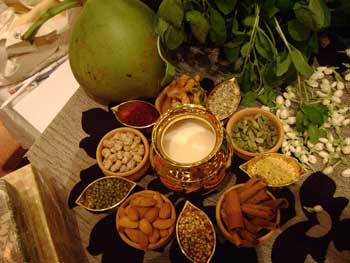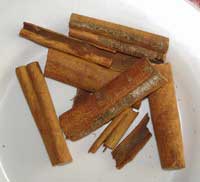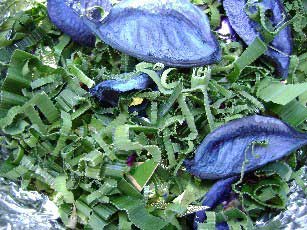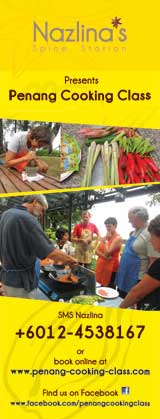
|
||
|
Follow @Nazlina
Usage of SpicesUsage of spices is endless. The word "spice" is a derivative of the Latin word "species".
It implies a big variety of types of plants in that group. Spices are therefore found everywhere. We find them in our meals, medicine, cosmetics and certain rituals.
There are of course countless instances about spices making their way in music, literature and also idioms. You must have heard about age old tradition of using spices to treat maladies or to ward of evil spirit. Also, how certain spices can deter poisonous reptiles from entering our homes, or how certain spices can keep food from getting spoiled. Spices also inspire a lot of art forms. Images of spices are found in pottery, daily household objects and become national icons. As we speak more and more good properties of spices are being discovered by science. In this page, you will learn about:
The Difference between Herbs and SpicesThe usage of herbs and spices usually goes hand in hand. What is the difference between herbs and spices? Herbs is the leaves or stalks of any types of edible plant, which usually have green leaves and soft stalks. Examples of herbs are: mint, bay leaves, basil, oregano and lemon grass. They can be used either fresh or dried. They are normally easy to grow and can be planted right out of small containers on your kitchen window sills. Local Malaysians normally have curry leaves, pandanus, lemongrass, turmeric and daun kesum in their patch of herb gardens.
Bigger herbs plant include kaffir lime, ginger, gelangal and bunga kantan. Curry leaves plant also can grow big at some suitable places. Other vegetables leaves which can be eaten like daun kaduk, daun salam, daun kunyit (turmeric leaves), ulam raja, cashew shoots and tapioca shoots are called "ulam". Ulam are rich in fibre and mostly green in color, hence, rich in folate and have many beneficial features such as anti-ageing properties and also enzymes to reduce the level of blood pressure, lessen diabetes problems and increase the nutrition in your body. Spices, on the other hand, come from:
They are usually sold dried, used either whole or in parts or grounded into powder. Spices are suitable for planting in certain parts of the world only. Usually, tropical islands with hilly terrains are suitable for growing them. Penang used to be the main grower of nutmeg and cloves in the world back in the 18th century. Now, Penang is one of the world players in I.C chip manufacturing! Agriculture takes the back seat. However, there are still some wonderful places you can viist to relive the bygone era, like the Tropical Spice Garden. Spices in Cooking
This is the most widely known usage of spices. A pinch of this or that makes a whole lot of difference to your cooking. Dishes without using spices taste so... SO bland. Drinks can contain spices too. Spiced wine had been made since medieval Europe. In Asia, ginger tea is very popular, added with honey or milk. Also popular is masala tea. Masala literally means "spice" in Tamil. Combination of a few spices makes up Garam Masala - "hot spice", always included in Indian curries. Ironically, "garam" in Malay means salt, another indispensable ingredient in any types of cooking. At a traditional Balinese spa for example, after your relaxing treatment you will be treated with herbal spicy tea flavored with honey. These special concoction will rejuvenate and improve the body circulation as well as refreshing your mind. Spices are also used for garnishing. Asian food which is garnished even with a sprinkle of fried onion or cut fresh chilies for example, tastes so much better than the one which is not. The rest of my web site is mostly about food, so I will move on to other usage of spices topics. Spices in Medicine
Traditional medicine is not complete without the addition of spices in one way or the other. Ancient people knew about the benefits of certain spices. Usage of spices in medicine is really extensive. After all, the Egyptians used spices to embalm the mummies. Ancient Chinese had 1001 medicinal uses for ginger. Ayurveda practitioners used spices to treat a myriad of maladies. It is apparent that the usage of herbs and spices after birth and during confinement is very good for nursing mothers. Many kinds of herbs and spices are also used as aphrosidiacs and for the well-being of men and women. In Malaysia and Indonesia, the use of "jamu" among women is practiced as soon as they reach puberty. Jamu is a variety of herbs and spices prepared in traditional ways. They are consumed in powder form and in drinks. Nowadays, jamu is conveniently prepared in capsule form and mass manufactured following stringent standards in pharmaceutical laboratories. Women who religiously consume jamu are well known for their beautiful skin, gorgeous hair, perfect complexion and shapely bodies. They follow strict lifetime routine, avoiding certain foods and observing some taboos to get that perfect external and internal Asian beauties look. At home, household remedies using spices are also very common. It is useful because most people have some kind of spices readily available in their homes. Do you know that the white paste dentists use to fill up the teeth contains clove? The resins of myrrh and similar agents are bacteriostatic - meaning the bacteria cannot grow in them. As a result, myrrh is used for this purpose in mouthwashes and toothpastes. In modern medicine, spices are used in many pills and powder which we hardly notice because they are processed in modern pills or capsules forms. Usage of spices are still being investigated in medical laboratories around the world as we speak. Spices in Traditional RitualsIt was written that Emperor Nero burnt a year's supply of cinnamon as a pyre for his dead Empress. Victorious soldiers marching into Rome were showered by expensive saffron. These extravagant usage of spices showed how powerful the spice trade was for the Roman empire. In Malaysia, special events which are steeped in tradition always include herbs and spices. For example, during the shaving ceremony of a newborn baby, there is a bowl of spiced scented water alongside kaffir lime, "sintok", a pinch of glutinuous rice paste and also turmeric. These paraphernalia are useful in case of bleeding on the infant's delicate head. To exorcise evil spirits, various spices are mixed with rice grains colored yellow with turmeric to be placed at strategic corners around the affected home. The shaman would sprinkle this magical potion while saying his mantra.
For weddings, usage of spices in every step of the ceremony is a must. Potpourri (called "bunga rampai") is made with pandanus, roses, bouganvillae blooms scented with rose water and a handful of cloves and cardamoms. Glutinous rice is dyed yellow with turmeric to symbolize good luck. The happy couple on the raised dias are sprinkled with rose water and spices for even more prosperity and good luck. Usage of Spices in Cosmetics, Aromatherapy and PerfumeryThe sense of smell is one that leaves the longest impression for human beings. Aromatherapy uses essential oil distilled from spices and herbs. A few drops of these oils invokes certain feelings, be it relaxation or sensual. They also have healing properties for some common illnesses. Perfumes are categorized as being floral, musky, citrusy or spicy, depending on the extract of the ingredients used in them. I was given once a perfume made of black pepper from Sarawak (a Malaysian state in Borneo). I loved it! In cosmetics and body care, body scrub can be made with ground ginger and turmeric. You can raid your kitchen to make a facial mask by mixing turmeric powder, egg white and honey. A traditional spa is not complete without steaming your body with spiced water and soaking in sweet smelling milk added with spices. What a terrific indulgence! All in all, usage of spices is everywhere. Life is definitely full of surprises and also spices. Back to the page of Malay Spices

Custom Search
|

Custom Search
Nazlina's Cooking Class in PenangAttend my cooking class to learn making traditional food.
The morning class includes Penang Market Tour.
PLEASE NOTE: We now offer PM classes, for vegan and vegetarians. Check out these handy tips for household remedies using spices. Learn how to plant daun kesum (also known as water pepper or Vietnamese mint). This herb is mainly used for making laksa or dishes with fish based gravy. |
|
|
|
||
|
|
||








New! Comments
Have your say about what you just read! Leave me a comment in the box below.